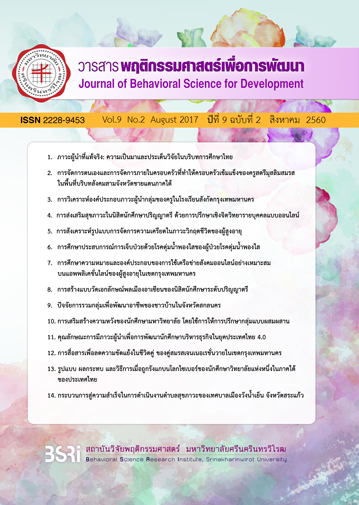ปัจจัยการรวมกลุ่มเพื่อพัฒนาอาชีพของชาวบ้านในจังหวัดสกลนคร Factor of Aggregation For Occupations Group Development in Sakonnakhon Village
Keywords:
Aggregation management, confirmatory factor analysis, group career developmentAbstract
This research aimed to 1) study factor to aggregation for occupations group development in Sakonnakhon Village Thailand and 2) study factors analysis for confirmatory factor to aggregation for occupations group development in Sakonnakhon Village. The research was descriptive using structural relationship model. The research samples were 400 villagers from 18 districts in Sakonnakhon Province. The research tool was questionnaire. The reliabilities were examined by Cronbach aplhas and all of items Corrected Item- total Correlation were greater than 2.0. The questionnaire had content validity and reliability (∞) of 0.220-0.709 that tools for samples and analysis. The exploring factor analysis by principle component analysis and orthogonal rotation by varimax method form SPSS for window were conducted. And study the confirmatory factor aggregation for occupations group development in Sakonnakhon Village by maximum likelihood. The findings manifested that: 1) The result of test for fitness model by Kaiser-Meyer-Olkin measure of sampling adequacy find KMO or MSA .935. The result of Bartlett’s Test of sphericity found that variables were relationship to significance .000 was less than .05 which was variables introduced to exploring factor analysis for the pattern of aggregation for occupations group development in Sakonnakhon Village. The result of Orthogonal rotation by varimax method into 3 components as follows: 1.Aggregation with ideal and race 2. Aggregation with management and interaction and 3. Aggregation with social 2) The result for study the confirmatory factor analysis of aggregation for occupations group development in Sakonnakon province. The result for remodel structure 3 time that construct validity. The research model is considered acceptable fit to the theories demonstrating Goodness-of-Fit indices as = 110.984, dƒ = 92, P-value = .087, /df = 1.206, RMSEA = .203, GFI = 0.970, CFI = .996, AGFI = .945, NFI = .976 and SRMR = .020 was conformed to the empirical data at a good criterion. The goodness of fit index indicated the good level which means the construct validity.
การวิจัยครั้งนี้มีวัตถุประสงค์ เพื่อศึกษาองค์ประกอบของปัจจัยการรวมกลุ่มเพื่อพัฒนาอาชีพของชาวบ้านในจังหวัดสกลนคร กลุ่มตัวอย่างคือชาวบ้านในจังหวัดสกลนคร 400 คน จาก 18 อำเภอ เครื่องมือที่ใช้เป็นแบบสอบถาม ใช้สถิติการวิเคราะห์องค์ประกอบเชิงยืนยัน และหมุนแกนแบบ Oblique Rotation โดยวิธี Varimax และประมาณค่าด้วยวิธีไลค์ฮู้ดสูงสุด ตรวจสอบความตรงของโมเดล ผลการวิจัย โดยใช้การวิเคราะห์องค์ประกอบ KMO มีค่าเท่ากับ .935 และ ค่า Bartlett’s Test of Sphericity ได้ค่านัยสำคัญ .000 แสดงว่าข้อมูลมีความสัมพันธ์กันสามารถนำไปวิเคราะห์องค์ประกอบได้ ผลการวิเคราะห์ได้ 3 องค์ประกอบ 1) การรวมกลุ่มทางวัฒนธรรม อุดมการณ์ และชาติพันธุ์ 2) การรวมกลุ่มการดำเนินงาน และการปฏิสัมพันธ์ และ 3) การรวมกลุ่มทางสังคม การศึกษาองค์ประกอบเชิงยืนยัน ผลการวิเคราะห์โมเดลสมการโครงสร้างตามสมมติฐานการวิจัยสอดคล้องกับข้อมูลเชิงประจักษ์ ปัจจัยการรวมกลุ่มเพื่อพัฒนาอาชีพของชาวบ้านในจังหวัดสกลนครมีความเที่ยงตรง
เชิงโครงสร้าง ( =110.984 ค่า / dƒ = 1.206 ไม่ควรเกิน 2 องศาอิสระ (dƒ) = 92
P-value = .087 ค่า RMSEA = .023 ค่า GFI = .970 ค่า CFI = .996 ค่า AGFI = .945
ค่า NFI = .976 และ SRMR = .020)


